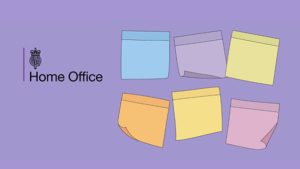
Global award-winning customs innovation —Border Force
- Zaizi transformed Border Force’s port scanning activities by digitising and automating workflows and eliminating manual processes.
- The secure, user-centred application empowers officers, enables data sharing, enhances decision-making, and paves the way for AI integration.
- Border Force won the prestigious Global Customs Innovation Award with ScanApp.
The client says…
“Zaizi have been great in terms of the day to day interactions between themselves and our project team. They understood the brief and worked quickly to establish user needs, with various users. The solution has landed well with our users, which demonstrates the work put in to get us to this point.”
Senior Border Force official
The brief
Border Force scans cargo at ports in the UK. Officers use intelligence to determine high-priority vehicles, trailers or containers to target for scanning. To modernise the operations, Border Force wanted to digitise and transform their freight scanning activities at ports.
The service had to:
- eliminate any remaining paper and manual processes
- allow officers to view scan data remotely and share information easily across ports
- allow senior stakeholders to monitor throughput/efficiency, and use the data for wider reporting
- prioritise user needs and take a user-centric approach to develop an intuitive and efficient service for frontline staff
The delivery
We took the project through discovery, alpha, and beta. The skills and expertise provided included:
- product management, service design, user research and UX/UI design
- business analysis, process automation and open-source BPM technology
- engineering, architecture, microservices development
- browser-based tools using open source technology
- CI/CD pipelines, cloud native application and dockerisation platforms.
User-centred approach
We embedded UCD team members from research, UX and content throughout and engaged end-users in each phase. Our extensive user research helped us pave the way for a smooth roll-out and discover essential operational needs, such as having uninterrupted access with offline mode — a crucial feature that addresses network reliability issues at some remote ports. This feature has gained particular interest among other Border Force departments dealing with the same issues.
Before rolling out to ports we took part in an Home Office internal assessment to ensure we met the Service Standard and identify any improvements for the next delivery phase.
Read: How our user-centred approach won the trust of frontline officers at the borders
Ways of working
We took the lead in a complex multi-vendor environment, using Agile methods and following the Digital Service Standards and accessibility guidelines.
Our team showed technical expertise to overcome challenges and deliver a solution that embedded a partner product and integrated with two other Home Office systems. It was also one of the first projects to build the environments and pipelines on Home Office in-house infrastructure.
We worked collaboratively with in-house teams from the Home Office and DDaT — from Design, Product, Infrastructure and Security to Quality Assurance and Business Change. We also helped to build skills and capabilities to support a smooth handover to live service.
The outcome
The application has transformed Border Force’s port scanning operations. It has:
- standardised the workflow and eliminated paper-based, manual processes.
- digitised and automated scanning/examination processes with a comprehensive audit trail
- enabled remote access to real-time scan data, shareable across ports
- established secure, role-based identity and access management
- provide real-time metric dashboarding, trends and scheduled reporting of operational and performance data.
- received positive feedback from frontline officers who find it intuitive, user friendly, and seamlessly integrated with wider Home Office systems.
- create a foundation for future technology integration — Zaizi has already investigated how AI can further improve operations
Award win: Border Force and ScanApp won the prestigious Global Customs Innovation Award. The award highlights cutting-edge solutions and forward-thinking innovations that address the evolving challenges customs administrations face worldwide.
“ScanApp will be the foundations we build future capability on, allowing future technology enhancements to be implemented effectively.”
Senior Border Force official
In internal surveys, users have given high scores on the product’s usability, speed and reliability. Here are just some of the anonymous user feedback:
“The ability to view images remotely via 2nd opinion is a real positive benefit of the ScanApp”
“It provides Detection staff with excellent tools to assist in our roles. Functions such as ‘second opinion’ are also extremely helpful and will be utilised thoroughly.”
“Much easier to use than I expected”
Other case studies
-

Our impact on digital government services in 2024
-

Helping local councils revamp taxi licensing to boost efficiencies and reduce costs
-

Wrap-up: Our impact on digital government services in 2023
-

Secure and cost-effective archiving of court judgments with serverless technology
-

From a stalled legacy system project to award-winning success
-

Working with users to improve support services for leaseholders and park home owners
